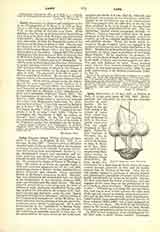

Lana, FRANCESCO, b. December 10, 1631, at Brescia in Italy; d. in the same place, February 22, 1687. Mathematician and naturalist, he was also the scientific founder of aeronautics. He belonged to the ancient family of the Counts of Lana Terzi, which had come to Brescia as early as the fourteenth century from the neighborhood of Bergamo. Trained by able teachers in his native city, he entered the novitiate of the Society of Jesus in Rome on November 11, 1647, and made his philosophical and theological studies in the Roman College of the Society. He later taught the humanities for a short time at Terni, where the town council through gratitude to him and his family granted him the freedom of the city. After this he was mainly engaged as professor of physical science and mathematics, principally at Ferrara, until delicate health necessitated his return to his native Brescia. He there performed the duties of confessor, and was engaged at the same time on the publication of his great work on physical science, “Magisterium naturie et artis”. Eliminating everything that was uncertain, this work was to treat in nine volumes the entire field of the natural sciences on strictly geometrical principles and on the basis of carefully made experiments. Unfortunately Lana himself could publish but two of these volumes (1684, 1686), but a third appeared at Parma after his death. The work found favorable notice in the learned publications of the time, though Lana’s principal achievement lay in another direction.
In 1670 he had published, as an advertisement for his chief work, a small volume entitled “Prodromoovero saggio di alcune invention”. In this book Lana describes a series of useful discoveries—for example, methods of cipher writing and of writing for the blind; an apparatus for speaking at a long distance; also telescopes, microscopes, a sowing machine, etc. Two chapters treat of aeronautics—chapter v, “How to construct birds which will fly through the air”, and chapter vi, “Demonstration of the f easibility of constructing a ship with rudder and sails, which will sail through the air”. Here Lana distinguishes explicitly between the “heavier than air” and the “lighter than air”. Although the various ingenious methods of constructing birds given in chapter v are very interesting, chapter vi is much more important. In this he devises a strictly scientific plan for the making of an airship: he begins by discussing the precedent conditions, then develops the plan, and finally solves the objections which might be advanced. According to his plan four large globes are to be made of very thin sheet metal of such diameter that the weight of the air contained therein will be greater than that of the sheet metal of which the globes are made. When the air is exhausted from the globes by means of a simple process explained by Lana, they will float through the air, and moreover carry a car for passengers. In the second volume of his great work (pp. 291-4), Lana again explains his plan, in which he says he has made some improvements. He also mentions that perhaps wood or glass might be substituted for the envelope of the globes. Lana’s plan aroused much interest and discussion. Though the Italian Borelli considered it impracticable, German savants, such as Leibniz and Professors Sturm and Lohmeier, spoke well of it. At all events, Lana’s influence on his successors was suggestive and encouraging; although his plan was never carried into execution, the principles so clearly set forth by him form the basis of modern aeronautics, and his importance is becoming ever more clearly recognized in our times. In addition to the works already mentioned, Lana also wrote a drama, “La Rappresantazione di San Valentino”, and an ascetical treatise, “La belt.), svelata”.
B. WILHELM

